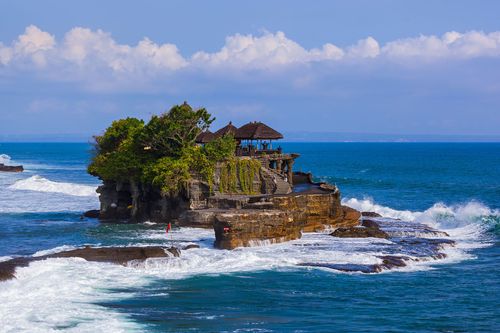#3 Release a sea turtle hatchling on Turtle Island
An island south of Sanur once reachable only by wading across at low tide or by boat, Pulau Serangan is best known as a place favoured by egg-laying sea turtles, earning it the nickname Turtle Island. Sadly, development disturbed the habitat which the Turtle Conservation and Education Center is trying to rectify. For a small donation you can adopt and release a hatchling in season, primarily June to October.
#4 Admire art at Museum Le Mayeur
Sanur’s main cultural sight, the Museum Le Mayeur, is former home of artist Adrien-Jean le Mayeur de Merprés (1880–1958). Having arrived in Singaraja in 1932, the 52-yearold Belgian settled in Sanur and set up his easel, painting canvases of 16-year-old beauty Nyoman Pollok and her friends.
Married three years later, the couple lived in the floridly carved house where around eighty of his works now hang: Impressionist early paintings from his travels in Europe, North Africa and India and romanticized canvases of Ni and her friends from the 1950s.
Imagine French Impressionism channelled by Gauguin and you’re close. The 1930s house is also interesting for its carving and for the couple’s furniture – Ni donated the property to the government on her death in 1985.
#5 Go snorkelling
Sanur is a popular destination for snorkeling enthusiasts. The crystal-clear waters and colorful coral reefs of Sanur offer a unique and unforgettable underwater experience. Snorkeling in Sanur is perfect for beginners, as the water is calm and shallow, making it easy to observe the stunning marine life.
You can expect to see a wide variety of fish species, including butterflyfish, angelfish, and parrotfish.
Sanur’s reef dives are only really of interest for beginners or as a refresher as the coral is unspectacular, the visibility so-so, and dives rarely descend beneath 12m. However, dive trips to Nusa Penida and Amed are offered by several schools and snorkelling trips (including gear) are also popular. There are a number of good dive centres in Sanur.
Best areas to stay in Sanur
There are beds to suit every budget in Sanur and few duds – quality is generally high and you get more space and better facilities for your rupiah or dollar here than in Kuta– Legian–Seminyak. Obviously, places with direct access to the beach command a premium.
Shorefront
The most higher end options tend to be on the beachfront. Here you’ll find large resorts plus a scattering of smaller, more affordable hotels - all generally with direct beach access.
Inland
For a cheaper base still, try the chain hotels and guesthouses near Ji Danau Tamblingan. Set back at a small stroll to the main action means these can be a great way to avoid beachfront tariffs.
Check the best accommodation in Sanur.
Best restaurants and bars in Sanur
Beachfront café-restaurants abound between Sindhu and Batujimbar but none stands out for cuisine, so stroll to the promenade and take your pick. The most authentic Indonesian food and cheapest eats are beyond the main drag, plus at the night market (6pm–midnight) inside the Sindhu Market at Jl Danau Tamblingan/Jl Danau Toba.
As for bars and nightlife, well Sanur is somewhat lacking. It’s got the nickname, “Snore”, but for many visitors that is exactly what they are after.
Here are the best places to eat in Sanur, Bali:
- ABC (Artotel Beach Club) ABC provides family entertainment on the beach. Start with a breakfast burrito for brunch/lunch or dine on seafood for dinner. A lagoon pool, playground, bars and a lounge complete the picture.
- Café Batu Jimbar This popular Sanur street-side spot specialises in Italian, Mexican as well as Indonesian food. They also serve healthy salads. On Sundays the café hosts a market selling fresh produce and a breakfast buffet with mouth-watering Balinese dishes.
- Café Smorgas This relaxed Swedish family-run café/restaurant serves up salads, sandwiches, burgers, wraps and main dishes, some of them inspired by Swedish cuisine. The family make their own home-made bread, cakes, pastries and jams.























